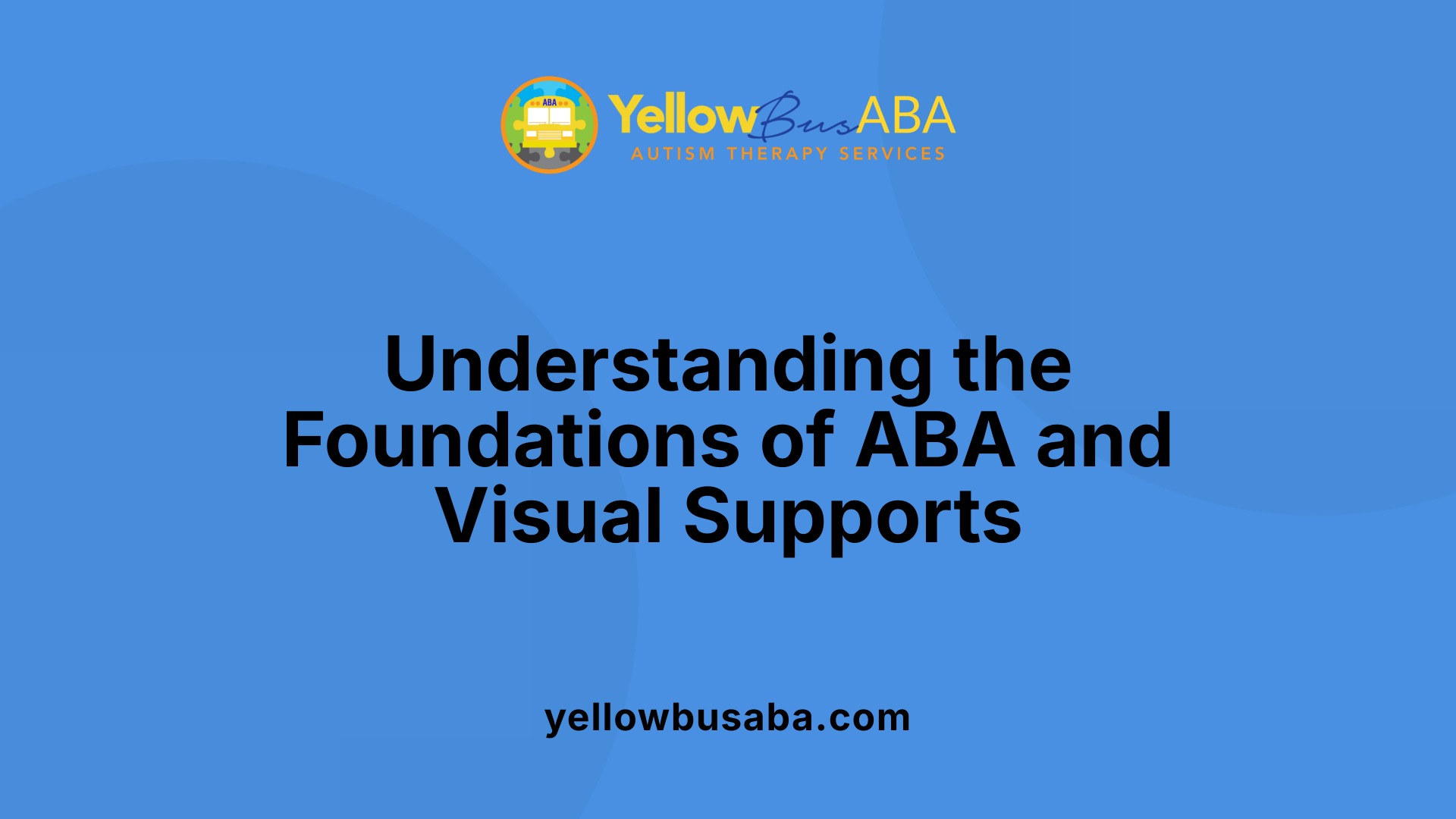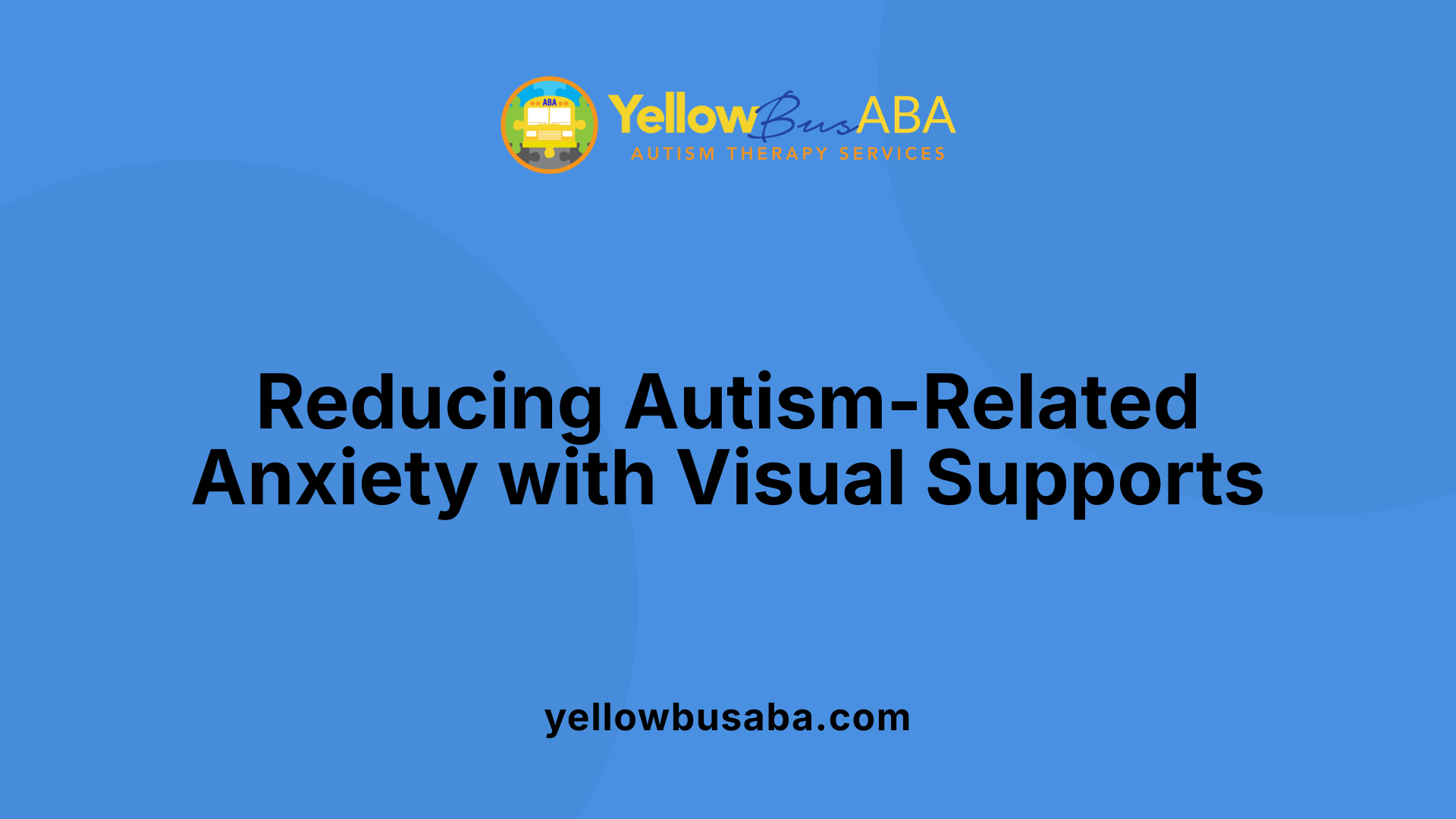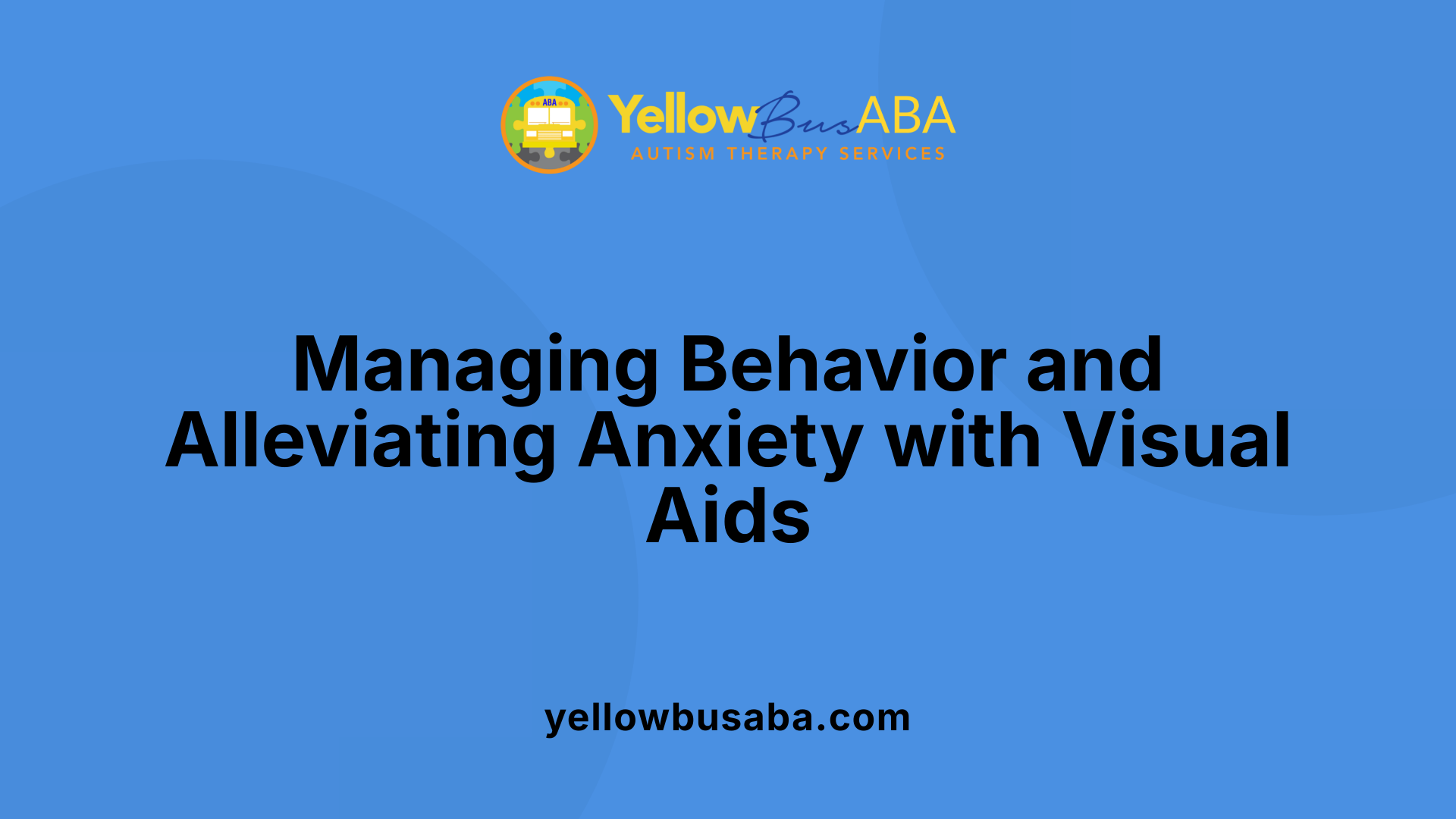The Role of Visual Aids in Reducing Anxiety
November 27, 2025
Harnessing Visual Supports to Ease Anxiety in Autism Therapy

Understanding Anxiety in Autism and the Power of Visual Aids
Anxiety is a common challenge faced by individuals with autism spectrum disorder (ASD), often stemming from difficulties in communication, understanding social norms, and navigating daily routines. Visual aids have emerged as a vital tool in applied behavior analysis (ABA) therapy, offering clarity, predictability, and alternative communication pathways that can significantly reduce anxiety. This article explores how visual supports function within ABA therapy to enhance communication, independence, and emotional regulation for individuals with autism, ultimately easing anxiety and promoting better behavioral outcomes.
Foundations of ABA Therapy and Visual Supports

What is Applied Behavior Analysis (ABA) therapy?
Applied Behavior Analysis (ABA) therapy is a research-driven approach aimed at enhancing social, communication, and learning skills primarily in individuals with autism. It uses behavioral principles such as positive reinforcement to encourage desirable behaviors and reduce challenging ones. ABA therapy is highly individualized, with treatment plans tailored to each child's specific needs and often includes strategies like Discrete Trial Training (DTT), Pivotal Response Treatment (PRT), and naturalistic methods such as the Early Start Denver Model (ESDM).
Sessions usually occur over 10 to 20 hours per week and emphasize promoting independence and social participation. Modern ABA incorporates play-based, naturalistic techniques focusing on the child's strengths and interests. Family involvement is also integral to support learning beyond clinical settings. Despite its proven effectiveness, ABA has been subject to debate concerning its intensity and goals, leading to ongoing adjustments in practice to better respect individual differences.
What is the role of visual supports in ABA therapy?
Visual supports are essential tools within ABA therapy, designed to enhance communication and understanding for children with autism. These supports include visual schedules, social stories, choice boards, and communication aids like augmentative technology. They break down daily routines and complex tasks into manageable, visually clear steps, helping children reduce anxiety and increase predictability.
By catering to the visual-processing strengths common in autism, visual supports enable children, especially non-verbal individuals, to communicate needs and navigate routines independently. For example, visual schedules reduce uncertainty by outlining daily activities, while choice boards empower children to make decisions without relying on spoken language. Social stories use visuals to teach social expectations and appropriate behaviors, which can decrease social anxiety. Visual supports also contribute to behavior management by making expectations and transitions clearer.
Consistent and collaborative implementation of these tools across settings like home and school enhances their effectiveness. Involving children in creating the visual aids boosts engagement and ownership of their routines, further promoting independence and communication skills.
Who typically provides ABA therapy services?
ABA therapy is usually delivered by a team of trained professionals specializing in behavioral intervention. The primary providers are Board Certified Behavior Analysts (BCBAs), who design and supervise individualized treatment plans. They ensure therapy aligns with each child’s needs and progress.
Supporting roles include Board Certified Assistant Behavior Analysts (BCaBAs) and Registered Behavior Technicians (RBTs), who work directly with children to implement daily therapy sessions, collect data, and encourage behavior change under BCBA supervision. These professionals often collaborate with caregivers, teachers, and other specialists to provide a comprehensive support network.
Services may be offered in diverse environments such as homes, schools, clinics, or community settings, leveraging visual supports and other evidence-based techniques to optimize learning and development. Ongoing assessment and monitoring enable continual adjustment of approaches to meet evolving needs effectively.
How Visual Aids Reduce Anxiety in Individuals with Autism

Mechanisms by which visual supports reduce anxiety
Visual aids help individuals with autism by creating clearer communication channels and breaking down complex information into manageable parts. This simplification reduces confusion and uncertainty, which often trigger anxiety. By offering concrete visuals, such as pictures or symbols, children better understand what to expect, which decreases feelings of stress.
Importance of predictability and structure
Predictability plays a crucial role in minimizing anxiety among children with autism. Visual supports add structure by organizing daily routines into clear, visible steps. This predictability helps the child anticipate upcoming activities, making their environment feel safer and less overwhelming.
Role of visual schedules and social stories
Visual schedules break daily activities into step-by-step visuals, promoting a secure routine and lowering anxiety levels. Likewise, social stories use graphic elements to explain social expectations and behaviors, supporting children in understanding social cues and reducing social anxiety. These tools encourage independence and confidence, which contribute to emotional stability for students with autism.
Enhancing Communication and Independence through Visual Supports

How does ABA therapy help individuals with autism?
ABA therapy helps individuals with autism by applying the science of learning and behavior to create personalized interventions. It promotes positive changes by increasing useful behaviors such as communication, social skills, and independence, while reducing harmful or disruptive behaviors. Through consistent use of techniques like positive reinforcement and environmental analysis, ABA therapy leads to improvements in language, socialization, and daily living skills, fostering greater independence and quality of life.
Use of choice boards and communication boards
Choice boards are visual tools that empower children with autism to make decisions non-verbally, fostering independence and enhancing communication skills. Alongside communication boards and augmentative technology, these visual supports provide alternative channels of communication especially for non-verbal children within ABA therapy. These aids reduce frustration by allowing children to express needs and preferences clearly without relying on speech.
Task analysis and visual breakdown for learning
Task analysis involves breaking down complex tasks into smaller, manageable steps, often accompanied by visual aids. This method helps children understand and master daily activities by presenting information in simple, digestible parts that match their visual-processing strengths. Visual schedules, for example, clarify routines by illustrating each step, which reduces anxiety and improves task comprehension.
Supporting non-verbal communication
Visual supports enhance communication for children who are non-verbal by offering alternative ways to interact and express themselves. They include communication boards, picture symbols, and visual cues tailored to the child’s needs. Incorporating these supports within ABA therapy not only facilitates clearer exchanges but also promotes social participation and independence.
Through combining these strategies—choice boards, task analysis, and non-verbal supports—ABA therapy addresses the unique communication and learning needs of children with autism, enabling them to engage more fully with their environments and develop vital skills.
Behavior Management and Anxiety Alleviation through Visual Supports

How Do Visual Supports Clarify Expectations and Aid Behavior Management?
Visual supports, including pictures, symbols, and schedules, provide clear and concrete information that help students with autism understand expected behaviors and routines. For example, visual schedules break down daily activities into manageable steps, which reduces uncertainty and anxiety. Choice boards enable children to make decisions non-verbally, promoting independence and communication, while social stories use visual narratives to teach social expectations and appropriate behaviors. Task analysis with visual steps helps children approach complex tasks confidently, further supporting behavioral regulation.
By making behaviors and routines explicit, these visual aids reduce confusion and frustration, fostering positive behavior and smoother transitions throughout the day.
Why Is Consistency Across Settings Important?
Consistent use of visual supports at home, school, and therapy sessions increases their effectiveness. When children see the same visual cues and routines consistently across environments, they better generalize the skills and behaviors being taught. This regular reinforcement minimizes anxiety caused by unpredictability and ensures that behavioral gains made during therapy persist in daily life.
Collaboration among therapists, parents, and caregivers is essential to maintain this consistency, which supports the child's learning and emotional well-being across contexts.
How Does Involving the Child and Family Enhance Visual Support Implementation?
Engaging children in creating their own visual supports boosts their motivation, ownership, and engagement. When children participate actively, the visuals reflect their preferences and comprehension levels, making them more meaningful and effective.
Families also play a crucial role by reinforcing the use of visual aids at home. Training and involving family members ensure that visual supports become an integrated part of the child’s routine, enhancing behavioral improvements and reducing anxiety.
Overall, visual supports in ABA therapy and educational settings not only clarify behavioral expectations but also reduce anxiety by providing predictability and structure. This collaborative, consistent approach empowers children with autism toward greater independence and emotional security.
Best Practices for Implementing Visual Supports in Autism Therapy

Identifying Individual Needs and Customizing Visuals
Effective use of visual supports begins with understanding each child's unique needs. Visual aids such as schedules, choice boards, or social stories should be tailored to the child's communication abilities and interests. Breaking down tasks into manageable visual steps helps children grasp routines and expectations with greater ease.
Engaging the child in creating these supports fosters ownership and increases engagement, making the aids more meaningful and motivating.
Collaborative Approaches Between Professionals and Families
Collaboration is essential for maximizing the benefits of visual supports. Therapists, teachers, and family members should work together to design, implement, and adjust these tools. This teamwork ensures that visuals are appropriate and effective across different environments.
Consistent communication among stakeholders allows for sharing observations and updates, helping refine visuals to suit evolving needs. Involving families also empowers them to reinforce strategies at home, extending gains made during therapy sessions.
Training and Consistent Usage Across Settings
Proper training ensures that everyone interacting with the child understands how to use the visual supports effectively. Consistency in implementation at school, home, and other settings strengthens skill generalization.
Updating visuals regularly to reflect changes in routines or abilities keeps supports relevant. Providing caregivers and educators with guidance and periodic refreshers reinforces correct usage, promoting independence and reducing anxiety for the child.
By combining personalized visuals with collaborative efforts and ongoing training, visual supports can be powerful tools in autism therapy to enhance communication, behavior management, and participation across environments.
Visual Supports: A Key to Reducing Anxiety and Enhancing Autism Therapy
Visual aids have proven to be indispensable in reducing anxiety and supporting behavioral improvements in individuals with autism. Within the framework of ABA therapy, these tools provide clarity, predictability, and accessible means of communication that address the core challenges faced by children and adults on the spectrum. Their effectiveness hinges on thoughtful customization, professional collaboration, and consistent application across environments. As awareness and research continue to grow, visual supports remain a cornerstone for fostering greater independence, reducing anxiety, and enriching the quality of life for those with autism and their families.
References
- Visual Supports for Students with Autism: Strategies and ...
- Visual Supports to Optimize ABA Therapy for Children with ...
- Visual supports at home and in the community for ...
- The Controversy Around ABA
- Applied Behavior Analysis (ABA)
- Applied Behavior Analysis (ABA) for Children With Autism
- Applied Behavior Analysis (ABA)
- The Top 10 Reasons Children With Autism Deserve ABA






